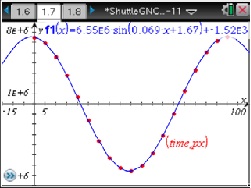NASA - Space Shuttle Guidance, Navigation, and Control Data

NASA - Space Shuttle Guidance, Navigation, and Control Data
In this activity, students will see how the position of the shuttle is deteremined and how the GNC officer ensures that the space shuttle arrives at its pre-determined destination as outlined by mission objectives.
Students will:
- gain an understanding of the M50 coordinate system;
- write a set of parametric equations based on a table of position coordinates over time; and
- differentiate parametric position functions to determine the velocity and acceleration vectors, as well as the magnitude of the velocity and acceleration.
The space shuttle is equipped with three Inertial Measurement Units (IMUs) that are used for attitude and position estimation. These three IMUs are mounted on the navigation base that is a metal beam used to maintain a constant orientation with respect to the rest of the vehicle.
At launch, the space shuttle's position in M50 coordinates is known. The IMUs have accelerometers that measure acceleration in the x, y, and z directions, as defined by the space shuttle's frame of reference. By integrating the acceleration data, the IMUs can determine the space shuttle’s velocity and position. This can then be used to determine the change in the initial M50 launch coordinates. The accuracy of this information is monitored by the GNC officer to ensure that the space shuttle arrives at its pre-determined destination as outlined by mission objectives.
Vernier EasyData,Vernier EasyLink and Vernier EasyTemp are registered trademarks of Vernier Science Education.

